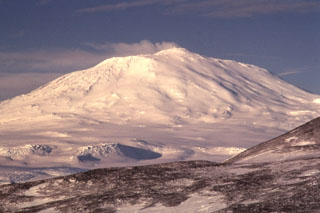Report on Erebus (Antarctica) — December 1977
Natural Science Event Bulletin, vol. 2, no. 12 (December 1977)
Managing Editor: David Squires.
Erebus (Antarctica) No apparent change in the lava lake; two small Strombolian eruptions
Please cite this report as:
Global Volcanism Program, 1977. Report on Erebus (Antarctica) (Squires, D., ed.). Natural Science Event Bulletin, 2:12. Smithsonian Institution. https://doi.org/10.5479/si.GVP.NSEB197712-390020
Erebus
Antarctica
77.53°S, 167.17°E; summit elev. 3794 m
All times are local (unless otherwise noted)
Philip Kyle and two associates visited the summit crater on 28 November. The persistent anorthoclase phonolite lava lake did not appear to have changed substantially since the previous observation in December 1976. The semicircular lake was ~130 m long and covered by an olive green crust, which was continuously being disturbed by minor upwellings. No major convective flow was noted.
Two small Strombolian eruptions originating from the lava lake and a small adjacent vent occurred during 5 hours of observation. One bomb was projected onto the main crater floor, 100 m above the inner crater floor. Large fresh bombs, up to 2 m long, were numerous around the NE main crater rim and were randomly scattered across the entire main crater floor, indicating that moderate Strombolian eruptions had occurred recently, probably during the previous 2-3 weeks. . . .
Geological Summary. Mount Erebus, the world's southernmost historically active volcano, overlooks the McMurdo research station on Ross Island. It is the largest of three major volcanoes forming the crudely triangular Ross Island. The summit of the dominantly phonolitic volcano has been modified by one or two generations of caldera formation. A summit plateau at about 3,200 m elevation marks the rim of the youngest caldera, which formed during the late-Pleistocene and within which the modern cone was constructed. An elliptical 500 x 600 m wide, 110-m-deep crater truncates the summit and contains an active lava lake within a 250-m-wide, 100-m-deep inner crater; other lava lakes are sometimes present. The glacier-covered volcano was erupting when first sighted by Captain James Ross in 1841. Continuous lava-lake activity with minor explosions, punctuated by occasional larger Strombolian explosions that eject bombs onto the crater rim, has been documented since 1972, but has probably been occurring for much of the volcano's recent history.
Information Contacts: P. Kyle, Ohio State Univ.

